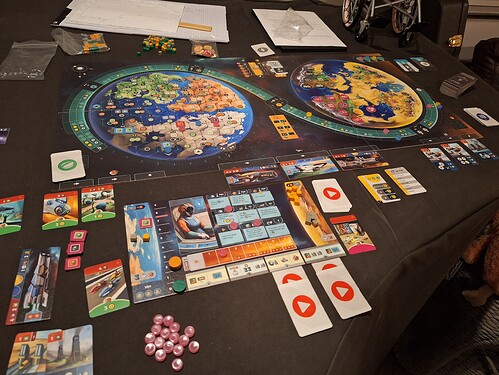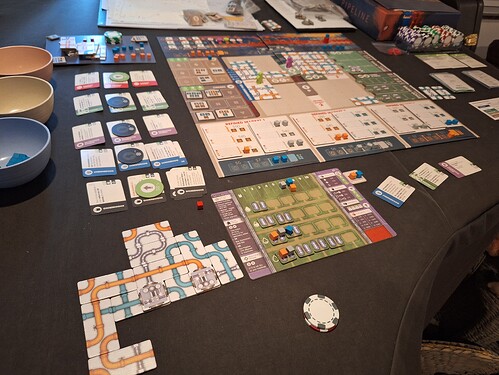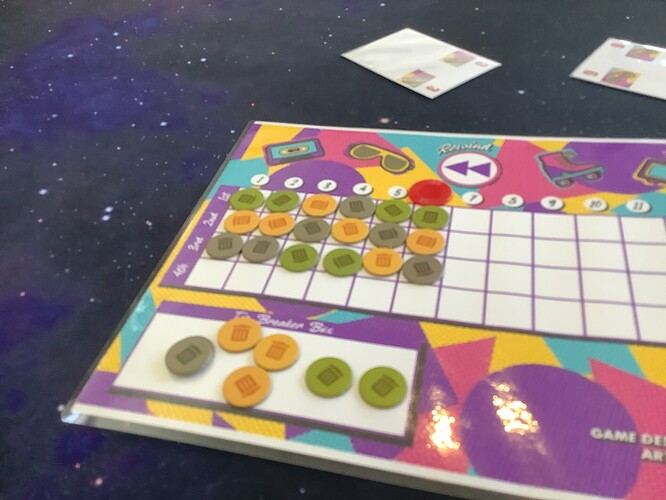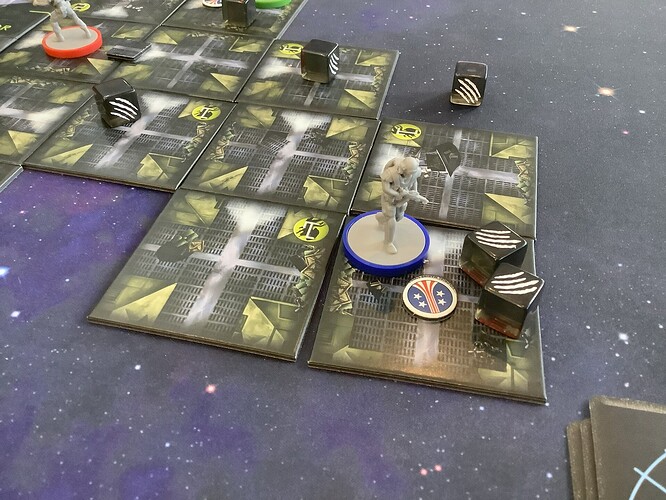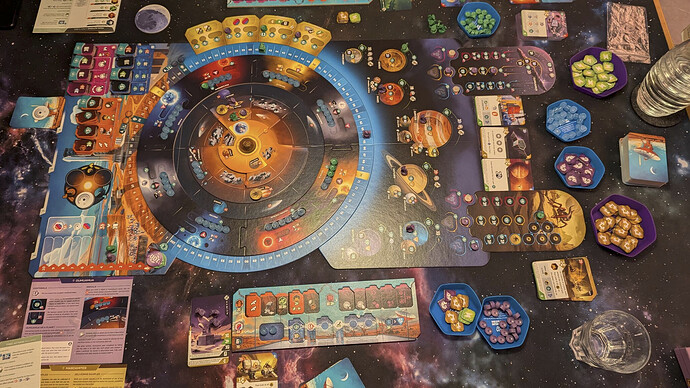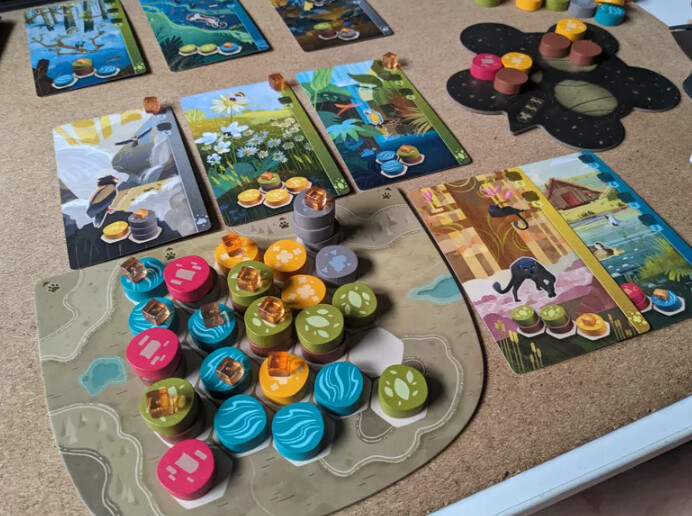I played a round of newly acquired SETI with my partner.
Here are some thoughts.
- I like the rulebook. It was easy to go through it to learn the game. Also all the edgecases I could find were annotated and thought of. This seems to have seen some thorough playtesting. Yay! (Example: “Can I take free actions during my pass turn to move my probes and deliver samples?” “Yes you can!”)
- The turning pieces of the board seemed gimmicky to me and I was very hesitant about the game because of it. I don’t like games with gimmicks. Turns out this is not only well produced (you could possibly light the sun with a small LED) but a well integrated central mechanism that I enjoyed a lot during the game. Yay again!
- Another thing: this game has a lot of stuff on the table. But once you learned the rules, it doesn’t seem that much anymore. Especially the per player area remains pretty neat and doesn’t take up too much space. I also like that the dual layer player boards are just foded boards stuck together which probably prevents warping and also is much cheaper to produce for CGE. Those are nice. Table hog but not overly so.
- Rules retention / mistakes: we consulted the rulebook twice during our game. One was the example above about free actions in passing turns and the other was also about the passing turn when to turn rotate the board. Except for one minor setup mistake with one of the technologies, we didn’t have any blunders.
- There are neat folding player aids that explain all the icons and we almost didn’t need them. But it’s nice they exist and thanks to the folding they don’t clutter the table.
- Everything fits into the box. No needless amounts of air. Just enough that one could build an insert which might be useful to have at least a little box thing for the techs which have to be sorted just so for every game.
That I have to mention some of these speaks to the level of quality that I have had on my table in recent years. CGE seem to have made a well-produced and well-developed game here.
Now, how to play:
- You win by points. On a tie the biggest Carl Sagan fan wins.
- The goal of the game is to discover up to 2 alien races (randomly chosen and hidden at the start) and research them by scanning the skies or sending out probes and processing the data you get to piece everything together.
- You gain points during the game from various sources and at the end for milestones and some cards you might have played.
- The game plays 1-4 players who play 5 rounds, taking turns until everyone has passed for a round.
- On your turn you take 1 action and as many free actions as you want. Possible main actions are:
- Launch a probe,
- Turn a probe into an orbiter,
- Turn a probe into a lander,
- Research Tech,
- Process data in your computer,
- Scan for signs of aliens,
- pay and play a card.
- Pass (rotate board, choose a card from round stack, gain income)
- Free actions include discarding cards for resources, spending energy to move probes. Fulfilling missions on cards. Placing acquired data in your computer.
- Resources are: money (used for cards, probes, scanning), energy (used for probes/scanning), publicity (mostly turns into tech), data (used to feed the computer)
- Cards are multi-use:
- discarding them gives you a resource or movement or VP.
- They are also assigned a sector for scanning purposes
- They have an income type associated
- Plus of course an actual action.
- Some cards stay in play for final VP
- Some cards have missions to fulfill (go to Venus, scan a sector etc)
On the player boards you have 3 sections:
- space for tech to improve your probes
- space for tech to improve your scanning
- the computer which contains spaces to insert tech to improve the computer
- You purchase tech with “Publicity” which you gain from cards or from visiting planets or comets with your probes. Whenever someone purchases tech a section of the board rotates. It’s always inner ring, then middle ring, then outer ring and back to inner. It is really hard to explain how this elevates the game but it really does.
Each section / tech type is associated with a color (red/yellow/blue), there are sectors also in these colors plus dark sectors and the discoveries that allow you to find and research the aliens also come in three colors.
- You gain yellow discoveries through probes either as landers or orbiters
- You gain red discoveries through scanning sectors
- You gain blue discoveries from processing data in the computer
To discover the aliens you need one of each type of discovery (I think that is the term used please forgive if not, I am writing from memory) per alien race. Once all 3 are filled (there are automations in place for lower player counts) around halfway through the game, the alien board is flipped, you get out the rules sheet and the cards for the aliens and a lot more opportunities for interesting discoveries. The alien cards are pretty strong and interacting with them is what brought me a decisive victory.
Also for having discovered them in the first place the players who made those discoveries start with some alien cards right away. So one should really try and get those discoveries done.
There is opportunity for tempo here and managing to do as much as you can on your turn. We both struggled with how few resources we had initially. We were both so low on money that it seemed impossible to get anything done.
On later turns I had some really nice action chaining with free actions helping me along to move my probe here, play a card to land my probe (main action) to pick up a sample (which turns into kind of a probe). Gain bonusses for landing. Move the sample to deliver it, gain some bonusses that allowed me to do something else and …
The cards themselves do not have tags like Terraforming Mars or Ark Nova. But it is a big stack of options. And with each card having up to 5 uses there is a lot of stuff you can do with them. If only to hoard them and exchange them for other stuff (handlimit at round end is 4 though).
All in all it plays fluently. A lot of turns I only did my main action. But sometimes it is worth considering which of the three rings will turn next and check where your probes will end up and if it is advisable to move now or later. This is a lot of fun trying to desperately trigger a rotation of the inner ring to align Earth (where probes start) with Mars and Jupiter just so…
My partner was frustrated because I won by a lot of points. Why did I win?
- I concentrated on probes.
- I had all 8 available probes on the board by the end of the game
- I had snagged the first spot in the probe milestone
- I had used the probes to interact with both alien races and obtained and used quite a lot of the alien cards
- I never once used a scan action until the last round of the game when it was the only thing left to do for a few points.
- I got the perfect tech first (accidentally, it allowed me to save energy on landing probes)
- I realized that the data analysis in the computer is not a primary thing to do. Because you get data only from scanning or landing probes and so I only pushed the computer later when I needed blue discoveries.
He on the other hand went for scanning. I am unsure if he could have done better. Scanning is a bit more of a group effort it seems and with 2 players and one of them ignoring this part of the game completely it might have been what cost him the most. This would be a sad thing because the game seems so balanced otherwise.
He didn’t concentrate on scanning either. He bought different techs from all 3 types. And while he pulled ahead initially because he went for an orbiter to gain additional income, it seems the lander bonusses (discoveries) end up being more powerful in the long run.
So I am looking forward to playing again. Even to teaching. This seems like long but easy teach. There is a lot to explain but with an excellent rulebook and a good player aid it seems doable. There is a solo mode included that I want to check out.
I highly recommend checking this out. Preliminary giving this 8/10 with a tendency to rise to a 9.
I would also like to note that Tomas Holek is a first time designer who went to Essen with 3 games this year (SETI, Galileo Galilei and Tea Garden) two of which are topping the Essen buzz list. Also Min & Elwen (Arnak) are listed on the development team for SETI.
PS: I can alredy see the expansions: more cards, more aliens, more milestones, different sectors. And we already got the Pluto promo card  Because Pluto is not on the board
Because Pluto is not on the board 
